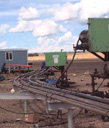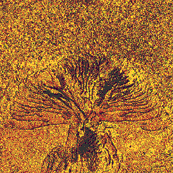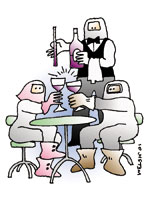
|
||
|
Technology at a Glance is a quarterly newsletter from the National Institute of Standards and Technology reporting on research results, funding programs, and manufacturing extension and technology services. If you have comments or general questions about this newsletter or if you would like to receive the four-page, color newsletter in hard copy, please email your mailing address to Gail Porter, editor, or call (301) 975-3392. About Technology at a Glance. [Technology at a Glance Search] [Technology at a Glance Archives] |
||
|
|
||
|
||
|
|
||
Composite Pipes Carry Oil and Gas In the Gulf of
Mexico and other parts of North America, oil and gas are being transported
through lightweight, corrosion-resistant pipes made of composite materials
instead of metals, a cost-saving innovation that took many years and
many hands to achieve. Composites—combinations
of materials, usually reinforced with high-performance fiber—are
difficult to produce economically and with the right characteristics
for structural applications. Five companies, a university, and a research
foundation finally achieved the necessary combination of materials
and processing advances in a five-year research project co-funded
by NIST’s Advanced Technology Program. The project was led by
Hydril Co. of Houston, Texas. The composite
pipe (also called spoolable tubing) consists of a thermoplastic lining
coated with epoxy reinforced by carbon and glass fibers. To make the
pipe, the research team developed reliable, economical filament winding/
manufacturing technology believed to be unique; perhaps the largest
database of composite characterization data in the industry; a resin
curing system and patented in-line cure monitor; and predictive design
software. Among the most
important technical achievements was the development of a raw materials
characterization database, which includes data on the interaction
of various combinations of materials, and an analytical methodology
for predicting the performance of products produced reliably and repeatedly.
This combination of advances enables the design of tubular components
that can be stored on spools. Another key innovation
was the development of cost-effective manufacturing technology, including
identification of the critical parameters that need to be controlled. More than 61,000
meters (200,000 feet) of the pipe have been installed for 20 customers
in four states and Canada. The pipe is used, for example, as liners
to rehabilitate out-of-service pipelines. In addition to its light
weight and corrosion resistance, the composite pipe typically costs
much less than alternatives on an installed basis. Other benefits
include resistance to chemical damage and fouling and reductions in
the number of required connections and fittings. Contact: Bill Stringfellow, (713) 941-6639 ext. 131.
|
||
Atomic Clock Uses Optical Frequency NIST researchers
have demonstrated a new kind of atomic clock that has the potential
to be up to 1,000 times more accurate than today’s best clock.
They reported the findings in July on Sciencexpress (www.sciencexpress.org),
an online publication of Science magazine. Today’s international
time and frequency standards measure a microwave frequency atomic
resonance of about 9 billion cycles per second. By contrast, the new
NIST device monitors an optical frequency more than 100,000 times
higher, or about one quadrillion cycles per second. The new clock
is based on an energy transition in a single trapped mercury ion (a
mercury atom that is missing one electron). Building a clock based
on such a high-frequency transition was previously impractical because
it requires both “capturing” the ion and holding it very
still to get accurate readings, and having a mechanism that can “count”
the ticks accurately at such a high frequency. Precise timekeeping
underlies much of the structure of modern civilization, including
navigation, electric power management, and communications. It also
has made possible significant advances in astronomy and physics. Today,
the best clocks are based on a natural atomic resonance of the cesium
atom—the atomic equivalent of a pendulum. For example, NIST-F1,
one of the world’s most accurate time standards, is based on
a microwave frequency and neither gains nor loses a second in 20 million
years. How good a clock
is depends on stability and accuracy—whether the clock provides
a constant, unchanging output frequency, and how close the measured
frequency is to the fundamental atomic resonance that provides the
clock’s “tick.” One advantage of the new clock based
on the optical frequency is that it ticks much faster. Contact: Scott Diddams, (303) 497-7459, sdiddams@boulder.nist.gov.
Corrective Lenses For UV Lithography NIST researchers
have uncovered a potentially serious optical problem affecting designs
for future generations of semiconductor manufacturing equipment
using deep ultraviolet light. Current state-of-the-art production
processes for semiconductor chips use deep ultraviolet lasers to
image circuits with critical features as small as 130 nm. The next
major steps for lithography are expected to be systems using even
shorter wavelength light, ultimately achieving feature sizes in
the range of 70 nm. Some of the
optics for current semiconductor production and all of the optics
for future generation semiconductor lithography are made of calcium
fluoride, one of only a few materials that are transparent at the
shorter wavelengths of deep ultraviolet light. NIST physicists recently
demonstrated experimentally that calcium fluoride crystals refract
light differently depending on the polarization of the light. Calculations
based on theory have confirmed the results. Lithography
equipment designers will have to account for this problem in the
optics design and try to minimize its impact, for example, by combining
particular relative orientations of the crystal axes of the various
lenses. Commercial vendors are modifying lens design modeling software
to include the effect on the system of the approximately 20 lenses
present in a typical optical lithography tool. It is expected to
be ready in October. NIST researchers are pursuing a potential solution
involving mixed crystals to null the effect at the illumination
wavelength. Contact: John Burnett, (301) 975-2679.
Designer Polymers To Aid Recycling While it may
look like a delicate tree drawn in the sand, the micrograph at right
shows the beginning of a crystallization process as a new type of
polymer is cooled down from its melt. The molecules of the polymer
fold into flat, branch-like crystals that grow into the remaining
amorphous liquid. Made with an atomic force microscope, the image
is part of an effort by NIST materials researchers to help chemical
manufacturers better understand how to tailor polymer blends to
optimize specific properties like strength, toughness, and surface
textures. Polyolefins
made with metallocene catalysts are a versatile class of polymers
that promises to help protect the environment while lowering the
cost of structural plastics. Such materials are used in making bumpers
for automobiles, as well as in many other applications. While previously
used only in inexpensive “commodity” products, the use
of improved catalysts for processing polyolefins now allows engineers
to design these plastics with very specific chemical structures
that improve strength, chemical stability, or other properties.
This makes polyolefins
prime candidates for improving the proportion of plastics used in
cars and trucks that can be recycled. The average car contains as
many as 30 different types of plastic. Unlike the steel or aluminum
in cars, the large number of different, incompatible plastics has
made recycling these materials very difficult. NIST researchers
hope that improving knowledge of polyolefin processing and properties
will make it possible to use this one type of plastic for many auto
parts, thereby substantially increasing the percentage of car materials
that are lightweight and also can be recycled. Contact: Charles Han, (301) 975-6772.
Liaison Office Focuses on AutosA newly organized
NIST Industrial Liaison Office now is working to maximize the impact
of NIST technical programs on industry. Currently, two pilot projects
are ongoing, one looking at the health care industry and the other
at the automotive industry. Staff members
for the Liaison Office will advise the NIST laboratories by getting
feedback from current and potential automotive industry customers.
They welcome suggestions and questions from automotive industry executives,
managers, and engineers. They also are available to give presentations
to auto industry groups on the NIST Automotive Project Portfolio,
which currently contains more than 60 projects. To help automotive
industry personnel find appropriate technical assistance from NIST,
the agency has posted a web page-www.nist.gov/automotive—providing
convenient links to dozens of relevant research projects. Contact: Clare Allocca, (301) 975-4359.
New Guides Explain Europe’s Standards
Three newly-issued NIST guides to European Union directives on machinery,
low-voltage equipment and electromagnetic compatibility can help U.S.
manufacturers carry out the steps necessary to The
easy-to-use introductory references are designed to acquaint businesses
and government officials with the directives’ essential requirements
and their relationship to other EU product safety laws. Each guide
lists the types of products covered by the particular directive (as
well as those that are excluded) and addresses issues regarding the
treatment of components incorporated into market-ready products. In
addition, the guides explain the hierarchy of EU, international, and
national standards that might be used to satisfy the directives. The
new publications are available at: http://ts.nist.gov/ts/htdocs/210/gsig/eu-guides/sp951/sp951.htm.
Contact: Maureen Breitenberg, (301) 975-4031.
|
||
Ferris Wheel Maker Rides High with MEP Since introducing the first portable ferris wheel in 1900, the Eli Bridge Company of Jacksonville, Ill., has been providing the United States and the world with the rides many of us consider an essential part of summer. However, while the company takes great pride in the quality and modern craftsmanship of its manufacturing, the firm’s system for tracking costs and inventory was out-of-date and inefficient, costing the small company time and money. The company contacted the Illinois Manufacturing Extension Center, an affiliate of the NIST Manufacturing Extension Partnership. After assessing the company’s entire operation, IMEC specialists helped the company select and install a new software tracking system. As a result, Eli Bridge reduced costs by $100,000 and created five new jobs. Contact: Tucker Kennedy, (309) 677-4633, tkennedy@imec1.org.
“Black Box” Enhances Medical Decision Making At a hospital in Indianapolis, the staff first learned that a patient had tuberculosis when a “black box” sent an alert to a pharmacist’s pager. Developed in part through a three-year project co-funded by the NIST’s Advanced Technology Program, the computerized decision-support system helped the staff isolate the highly contagious patient more quickly than was otherwise possible. The clinical alert system was developed by Sunquest Information Systems of Tucson, Ariz. Currently operating in seven hospital groups in six states, the alert system provides critical lab test results, adverse drug event monitoring data, and other information to medical staff by pager, e-mail, fax, or printer. It helps save money in a variety of ways, such as suggesting changes from intravenous to less expensive oral medications. Sunquest estimates that the alert system could save a hospital hundreds of thousands of dollars annually. Contact: Chris Mason, (801) 588-6020.
|
||
Abnormal
Bleeding—A new procedure for treating abnormal uterine bleeding
is a result of cooperative research between NIST and CryoGen Inc.,
of San Diego. The Food and Drug Administration recently approved the
procedure, which uses a catheter based on NIST technology that can
reach temperatures of -150 to -190 degrees Celsius at the tip. The
catheter is inserted into the uterus where it freezes problem tissue.
According to a review in Family Practice News, the treatment
was successful in clinical trials, with patients typically discharged
30 minutes after the procedure and with nearly all returning to work
the following day. E-Business
Testbed—Many smaller firms have been slow to use e-business
tools. Confusion and lack of understanding about benefits, opportunities,
and limitations of e-business are among the reasons. To help manufacturers
better understand e-business and information technology strategies,
NIST’s Manufacturing Extension Partnership is developing an e-Business
Demonstration Testbed. The testbed will be used by MEP centers nationwide
to demonstrate and simulate e-business applications. MEP is inviting
companies to participate by providing commercial, off-the-shelf e-business
Internet-based applications for improving communications, integrating
the ordering process with enterprise resource planning and accounting,
and transferring data within a supply chain. Non-linear Electronics—NIST and the University of Colorado at Boulder are planning a joint research center to support development of simulators and measurement systems for non-linear electronics in wireless communication systems. To maximize battery life in wireless devices, electronics engineers are using radio frequency power amplifiers in the non-linear regime (where output is not proportional to input). However, lack of adequate simulators and measurement systems have hampered design efforts. The new center will be supported by a consortium of companies with a common need for non-linear electronics measurement, modeling, and design tools. For further information, see www.boulder.nist.gov/nonlinear. Contact: Don DeGroot, (303) 497-7212.
|
||
About Technology at a Glance:NIST is an agency of the US Department of Commerce's Technology Administration. NIST develops and promotes measurements, standards, and technology to enhance productivity, facilitate trade, and improve the quality of life. Technology at a Glance is produced by Public and Business Affairs, NIST, 100 Bureau Dr., Stop 3460, Gaithersburg, Md. 20899-3460. Any mention of commercial products is for information only; it does not imply recommendation or endorsement by NIST. Technology at a Glance Editor: Gail Porter, (301) 975-3392, email: gail.porter@nist.gov. For patent information, call (301) 975-3084. Technology at a Glance Archive Files
Created: 9/20/2001 Last updated: 11/9/2001 Contact: inquiries@nist.gov
|

 NIST
researchers have learned how to deposit defect-free copper wires into
the ever-thinner and ever-deeper trenches that will traverse the multi-tiered
real estate of future integrated circuits. The research may well produce
a “model answer” for an industry-identified problem with
no known solution that many experts in the field see looming in the
coming years.
NIST
researchers have learned how to deposit defect-free copper wires into
the ever-thinner and ever-deeper trenches that will traverse the multi-tiered
real estate of future integrated circuits. The research may well produce
a “model answer” for an industry-identified problem with
no known solution that many experts in the field see looming in the
coming years.

 Burning
toast, shower steam, and dust—all common household occurrences—can
set off an even greater annoyance, false smoke detector alarms. Too
often, people disconnect their smoke detectors over these false alarms,
depriving themselves of a potentially life-
Burning
toast, shower steam, and dust—all common household occurrences—can
set off an even greater annoyance, false smoke detector alarms. Too
often, people disconnect their smoke detectors over these false alarms,
depriving themselves of a potentially life- NIST
chemists recently demonstrated that their measurements of lead in
wine are among the most accurate in the world. NIST was one of 14
National Measurement Institutes participating in an international
pilot study of how accurately the official national standards agencies
measure lead in wine. This study is one of many scientific measurement
intercomparisons that are being conducted by the International Bureau
of Weights and Measures. All participating institutes performed very
well. They agreed very closely on the ultralow level of lead in the
wine samples provided by the Institute for Reference Materials and
Measurements in Geel, Belgium. NIST chemists made their exceptionally
accurate measurements of the trace amounts of lead in the wine in
a new Advanced Chemical Sciences Laboratory clean room facility in
Gaithersburg, Md. The results of this study could help prevent measurement
disagreements from becoming barriers to U.S. wine producers who wish
to export their products overseas. Contact:
NIST
chemists recently demonstrated that their measurements of lead in
wine are among the most accurate in the world. NIST was one of 14
National Measurement Institutes participating in an international
pilot study of how accurately the official national standards agencies
measure lead in wine. This study is one of many scientific measurement
intercomparisons that are being conducted by the International Bureau
of Weights and Measures. All participating institutes performed very
well. They agreed very closely on the ultralow level of lead in the
wine samples provided by the Institute for Reference Materials and
Measurements in Geel, Belgium. NIST chemists made their exceptionally
accurate measurements of the trace amounts of lead in the wine in
a new Advanced Chemical Sciences Laboratory clean room facility in
Gaithersburg, Md. The results of this study could help prevent measurement
disagreements from becoming barriers to U.S. wine producers who wish
to export their products overseas. Contact: